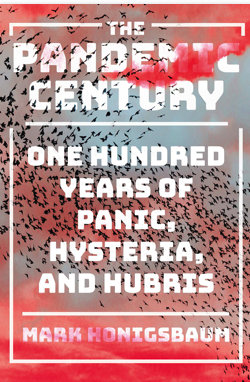The latest book on pandemics and infectious disease that I’ve made my way through is Mark Honigsbaum’s The Pandemic Century: 100 Years of Panic, Hysteria, and Hubris, “a book about these events and processes, and the reasons why, despite our best efforts to predict and prepare for them, they continue to take us by surprise.” That theme is an important one that deserves attention as time and again, a new infectious disease threat appears and calamity ensues. This cycle repeats over and over.
True to the panic and calamity aspect, Honigsbaum begins his book discussing shark attacks occurring in the North Atlantic, a supposed venue in which such attacks were not known to occur. Sound familiar? We’ve heard that a lot: Ebola doesn’t occur in West Africa, Zika doesn’t occur in the Western Hemisphere, Chikungunya is restricted in its geographic spread, etc etc
Infectious diseases — though we try to find strict laws of nature to confine them — are fluid physical phenomena whose dynamics are influenced by countless factors that are very hard to account for in models and cannot be dogmatized. It is not a foregone conclusion that each pandemic threat can be easily beaten back as we have seen with malaria, tuberculosis, influenza, and HIV (to name a few prominent ones). As New York Times science journalist Carl Zimmer notes in his review of the book: “What made this past century unusual was not pandemics per se, but our expectations about beating them. The germ theory of disease and other scientific advances in the 19th century fostered a sense of mastery over the microbial world.”
Honigsbaum’s book is divided into several chapters recounting various outbreaks and pandemics. Some of these are familiar such as the 1918 influenza pandemic, the 1976 Legionnaire’s Disease outbreak, SARS, and HIV. However, some are less familiar such as the parrot fever (psittacosis) outbreak that occurred in 1930s America. Of this outbreak, Honigsbaum colorfully writes:
Perhaps the most important factor of all, however, had been the popularity of lovebirds with American consumers and the lucrative interstate trade that saw itinerant peddlers going door-to-door offering parakeets to widows and housewives. In 1930, the idea that these cute American-bred birds might be the avian equivalent of Trojan horses was too disturbing to contemplate.
I recommend this book to those who want an easily digestible account of pandemics and outbreaks that are not only headline-grabbing but reveal holes in our preparedness and knowledge regarding infectious disease and microbiology. When each outbreak occurs, it is invariably followed by conspiracy theories, fake news, panic, sometimes disregard, and a whole host of other human responses that are driven by the uncertainty that characterizes the early days of a response. This is nothing new and is something that will continue but will hamper response and containment activities. The value of learning the history contained in this book is as Carl Zimmer notes in his review, “Surely the value of understanding history is that it gives us a chance to stop repeating our mistakes.”

